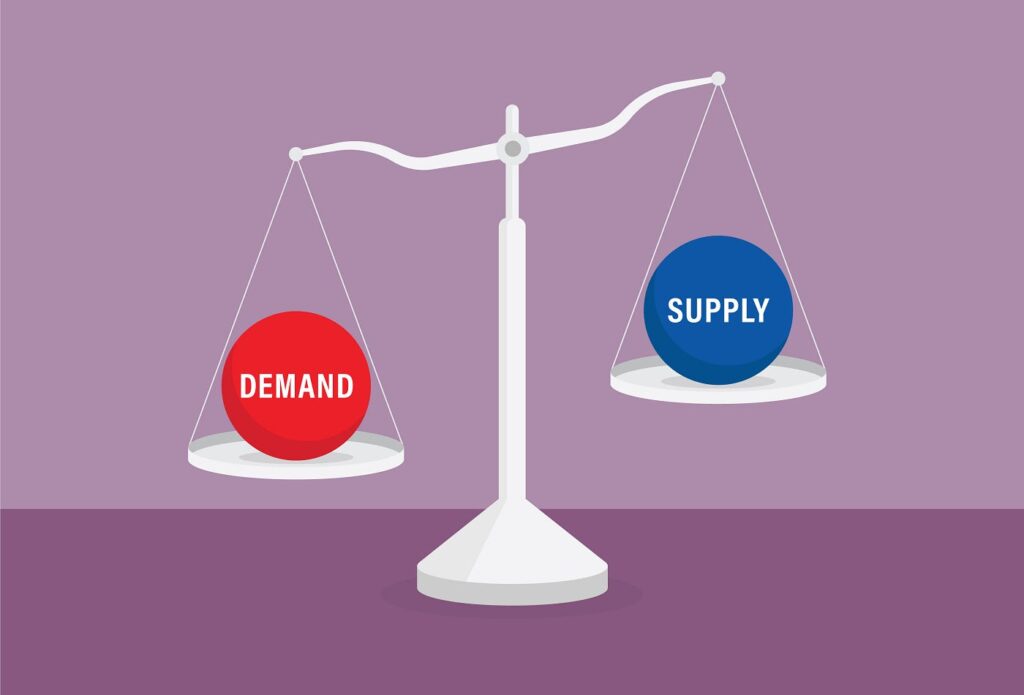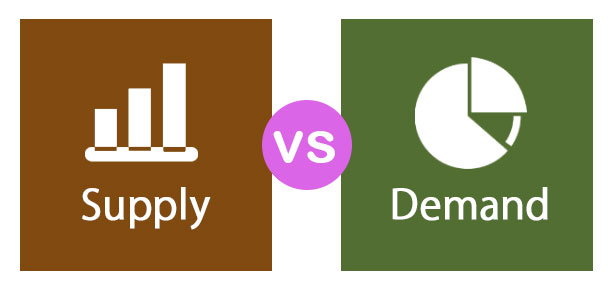Supply and demand, the two fundamental forces shaping the stock market, operate like the heartbeat of this complex market. A deep understanding of these concepts and their interactions is key to unlocking the mysteries of stock price movements. This article provides a detailed look at the dynamics of supply and demand, offering powerful tools for analysis, forecasting, and decision-making to investors, enabling them to navigate the ups and downs of the stock market with greater awareness.
What is Supply?
Supply in the stock market refers to the number of shares of a company that are available for sale. In other words, supply indicates how many shares shareholders are willing to sell at the current market price.
Various factors influence the supply of stocks:
– The total number of shares issued by the company
– Initial public offerings (IPOs) and secondary offerings
– Stock buybacks by companies
– Stock splits or consolidations
– Mergers and acquisitions
It is important to note that stock supply typically changes slowly. An increase in supply through the issuance of new shares or a decrease through stock buybacks are time-consuming processes that occur gradually.
What is Demand?
Demand in the stock market refers to the willingness and ability of investors to purchase shares at various prices. Demand indicates how many shares buyers are willing to purchase at the current market price.
Factors influencing stock demand include:
– Economic data and outlook
– Interest rates
– Financial results and forecasts of companies
– Important news and events related to the company or industry
– Market sentiment and psychology
In contrast to supply, demand can change quickly and dramatically. Positive news can rapidly increase demand, while negative news can lead to a swift decrease in demand.

Equilibrium Point of Supply and Demand
The equilibrium point of supply and demand is the price at which the quantity supplied equals the quantity demanded. At this point, the number of shares sellers are willing to sell is equal to the number of shares buyers are willing to purchase.
Key characteristics of the equilibrium point include:
– At this point, the stock price tends to stabilize.
– Buying and selling pressures are balanced.
– Trading volume is typically high at this point.
However, the stock market rarely remains at a perfect equilibrium point. Prices are constantly fluctuating as supply and demand continually change. When demand exceeds supply, prices rise. Conversely, when supply exceeds demand, prices fall.
Understanding this dynamic is crucial for analyzing market trends. Changes in supply and demand can indicate fundamental changes in a company’s value or shifts in market sentiment. Analysts and traders can identify investment opportunities and adjust their trading strategies by examining these patterns.
In summary, understanding the concepts of supply, demand, and equilibrium point forms the foundation of stock market analysis. These concepts help investors better understand price dynamics and make more informed decisions.
Factors Influencing Supply and Demand in the Stock Market
Supply and demand in the stock market are affected by a wide range of factors. These factors can vary from micro-level (such as the performance of a specific company) to macro-level (such as global economic conditions). Understanding these factors is crucial for investors and market analysts, as it helps them better predict market trends and make more informed decisions.
In this section, we focus on the factors influencing the supply of stocks. Supply usually changes more slowly than demand, but changes in supply can have a significant impact on prices. The three main factors that influence stock supply are company performance, macroeconomic conditions, and political and international events.
– Company Performance: Company performance is one of the most significant factors affecting stock supply. This factor encompasses various aspects of a company’s operations:
– Profitability Companies with high profitability typically have less inclination to increase stock supply through issuing new shares. They may even opt for stock buybacks, which reduces supply.
– Need for Capital: Companies requiring investment or financing may decide to raise capital by issuing new shares, which increases supply.
– Corporate Strategies: Strategic decisions such as mergers and acquisitions, stock splits, or changes in capital structure can impact stock supply.
– Future Outlook: If the management of a company has a positive outlook for the future, they may be less inclined to sell shares, thereby limiting supply.
Macroeconomic Conditions
Macroeconomic conditions also play a crucial role in determining stock supply, depending on the following factors:
– Interest Rates: Low interest rates typically increase companies’ willingness to finance through debt rather than issuing stock, which can limit stock supply.
– Economic Growth: During periods of economic growth, companies may issue new shares to finance their expansion projects, leading to increased supply.
– Inflation: High inflation may cause companies to avoid issuing new shares to preserve the real value of their existing shares.
– Capital Market Conditions: In bullish markets, companies may be more inclined to issue shares as they can receive higher prices for their stocks.
Political and International Events
Political and international events can also influence stock supply based on the following factors:
– Regulatory Changes: Changes in tax laws, capital market regulations, or corporate laws can affect companies’ decisions regarding issuing or buying back shares.
– Geopolitical Tensions: International tensions or political instability may cause companies to act more cautiously when issuing new shares.
– Trade Agreements: New trade agreements or changes in trade relations between countries can impact companies’ strategies and, consequently, their decisions regarding stock supply.
– Global Crises: Events such as pandemics or global financial crises can lead to significant changes in stock supply, as companies may need to sell shares to ensure liquidity or, conversely, avoid issuing new shares.
Understanding these factors and how they influence stock supply helps investors gain a more comprehensive view of market dynamics. This knowledge can assist them in predicting potential changes in stock supply and, consequently, price changes.

Factors Influencing Demand in the Stock Market
Factors influencing demand in the stock market play a key role in determining prices and market trends. Unlike supply, which typically changes slowly, demand can rapidly and dramatically be affected by various factors. Understanding these factors is crucial for investors and market analysts, as it helps them make more informed decisions about buying, selling, or holding stocks.
Investor Expectations about the Company’s Future
Investor expectations about a company’s future are one of the most significant factors influencing stock demand. These expectations are formed based on a combination of various factors, including the company’s past financial performance, future strategies, competitive positioning in the industry, and the overall market outlook. When investors have positive expectations about a company’s future, they are more inclined to buy shares, leading to increased demand and, consequently, higher stock prices. Conversely, if investors are pessimistic about a company’s future, demand for its shares may decrease.
Various factors can influence investor expectations. For example, the announcement of strong financial results, the introduction of innovative new products, or expansion into new markets can create positive expectations. On the other hand, operational challenges, intense competition, or adverse changes in industry regulations can lead to negative expectations. Investors also pay attention to news and analyst reports, which can help shape their expectations.
Interest Rates and Alternative Bonds
Interest rates and alternative bonds are another important factor affecting stock demand. Interest rates and bond yields have an inverse relationship with the attractiveness of stocks. When interest rates are low, investors are more inclined to invest in stocks because the returns on bank deposits and bonds appear less attractive. This can lead to increased demand for stocks and, consequently, rising prices.
Conversely, when interest rates rise, bonds and other fixed-income instruments can become more attractive. This can lead to decreased demand for stocks, as some investors may move their capital from the stock market to safer options with fixed returns. Therefore, changes in interest rates and bond yields can significantly impact demand patterns in the stock market.
Market Liquidity
Market liquidity is also a crucial factor in determining demand for stocks. Liquidity refers to the ability to buy or sell an asset quickly without significantly impacting its price. Markets with high liquidity are typically more attractive to investors, as they can easily enter or exit positions. This attractiveness can lead to increased demand for stocks in liquid markets.
Several factors can influence market liquidity. For example, expansionary monetary policies can increase liquidity throughout the economy, some of which may flow into the stock market. Additionally, the presence of large and active institutional investors in the market can help enhance liquidity. On the other hand, economic crises or severe uncertainty can lead to reduced liquidity, as investors may prefer to keep their money in safer assets.
Understanding these factors and how they influence stock demand helps investors gain a more comprehensive view of market dynamics. This knowledge can assist them in predicting potential changes in stock demand and, consequently, price changes, enabling them to adjust their investment strategies in accordance with market conditions.
Here’s a summary and organization of the content you’ve provided regarding stock price predictions through supply and demand analysis, along with trading strategies:
Predicting Stock Price Trends Through Supply and Demand Analysis
By combining the analysis of curve slopes and changes in equilibrium points, analysts can make predictions about future stock price trends. These predictions are based on several factors:
– Changes in Fundamental Factors: Analysts examine whether shifts in fundamental factors such as a company’s profitability, industry outlook, or macroeconomic conditions can lead to changes in supply or demand curves.
– Historical Patterns: By analyzing historical changes in supply and demand, analysts can forecast potential future trends.
– Volume Analysis:Trading volume can indicate the relative strength of buyers and sellers. An increase in volume alongside rising prices can signal strong demand, while increasing volume with falling prices may indicate selling pressure.
– Support and Resistance Levels: These levels can indicate temporary equilibrium points in supply and demand. Breaking through these levels can signal a change in the supply-demand balance.
However, it’s important to note that accurately predicting stock prices is always challenging, and unforeseen factors can impact price trends. Therefore, supply and demand analysis should be used as one of several decision-making tools alongside other analytical methods.
Trading Strategies Based on Supply and Demand
Trading strategies based on supply and demand allow traders to make informed decisions using fundamental economic principles. These strategies are designed by carefully analyzing supply and demand patterns in the market and identifying profitable opportunities based on existing or anticipated imbalances. Three main strategies are:
- Trend Trading:
– This is one of the most common trading strategies, based on the principle that “the trend is your friend.” In this strategy, the trader attempts to identify the prevailing supply and demand trend and trades in that direction.
– In an Upward Trend: Demand exceeds supply, and prices are rising. Traders look for buying opportunities, using indicators like moving averages or bullish chart patterns to confirm the trend.
– In a Downward Trend: Supply exceeds demand, and prices are falling. Traders seek selling opportunities or short-selling, using indicators like breakdowns of support levels to confirm the trend.
The main advantage of this strategy is that the trader moves with the dominant market flow, increasing the likelihood of success. However, the challenge lies in accurately identifying entry and exit points, as late entries can lead to buying high or selling low.
- Counter-Trend Trading:
– This advanced strategy involves identifying potential reversal points in the prevailing supply and demand trend. It is based on the principle that every trend eventually ends and reverses.
– In a Strong Upward Trend: Counter-trend traders look for signs of weakening demand or increasing supply, which may include technical divergences or strong resistance levels. They may consider short positions in these cases.
-In a Strong Downward Trend: These traders look for signs of decreasing supply or increasing demand, such as strong support levels or increasing trading volume at low prices. They may consider long positions here.
The main advantage of this strategy is the high profit potential if successful, as the trader can enter trades at key reversal points. However, it carries high risk due to the difficulty in accurately identifying reversal points, which may lead to significant losses if the trend continues.
Here’s a structured summary of the information regarding trading at equilibrium points, key insights on supply and demand analysis, and practical tips for traders:
Trading at Equilibrium Points
Definition:
Trading at equilibrium points is a strategy that focuses on identifying and utilizing temporary equilibrium points between supply and demand. At these points, prices usually fluctuate within a specific range, where supply and demand are nearly balanced.
Strategy:
– Traders seek to identify these price ranges and profit from small price movements within them.
– Typically, they buy near the bottom of the range and sell near the top, assuming that prices will remain within this range.
Application:
– This strategy is often used in non-trending markets or during short-term price consolidations between major trends.
Advantages:
– Relatively low risk, as traders can place stop-loss orders close to their entry points.
Challenges:
– The main challenge is identifying when the balance is broken and a new trend begins. Traders must be ready to exit their positions quickly if prices move outside the predetermined range.

Key Insights and Practical Tips for Supply and Demand Analysis
Supply and demand analysis is a fundamental tool in the stock market that helps investors and traders gain a deeper understanding of market dynamics and make informed decisions. Here are some essential tips for effectively using this method:
- Attention to Fundamental Factors:
– Supply and demand are influenced by various fundamental factors, including a company’s financial performance, macroeconomic conditions, industry changes, and geopolitical events. Analysts should consider these factors to predict potential changes in supply and demand.
- Volume Analysis:
– Trading volume can provide crucial insights into the relative strength of supply and demand. An increase in volume along with rising prices can indicate strong demand, while increasing volume with falling prices may suggest selling pressure.
- Identification of Key Levels:
– Support and resistance levels can indicate important temporary equilibrium points between supply and demand. Breaking through these levels can signal a change in the supply-demand balance.
- Long-Term Trends:
– While short-term fluctuations can be misleading, long-term trends often provide a more accurate picture of supply and demand balance. Analysts should look for stable patterns over time.
- Utilization of Technical Tools:
– Technical analysis tools, such as moving averages, the Relative Strength Index (RSI), and Bollinger Bands, can aid in identifying changes in supply and demand.
- Consideration of Psychological Factors:
– Market sentiments and herd behavior can significantly impact supply and demand. Analysts should also consider these psychological factors.
- Flexibility in Analysis:
– Markets are dynamic, and conditions can change rapidly. Analysts should be prepared to adjust their perspectives based on new information.
- Combination with Other Analytical Methods:
– Supply and demand analysis should be used alongside other analytical methods, such as fundamental and technical analysis, to provide a more comprehensive view of market conditions.
By incorporating these key insights and practical tips, investors and traders can effectively use supply and demand analysis as a powerful decision-making tool in the stock market.
Advantages and Limitations of Supply and Demand Analysis
Supply and demand analysis in the stock market is a powerful tool for understanding market dynamics and predicting price movements. This analytical method helps investors gain a deeper insight into the driving forces of the market and make more informed investment decisions. However, like any other analytical method, supply and demand analysis has its advantages and limitations that should be considered.
Advantages:
– Better understanding of market dynamics and factors influencing stock pricing
– Helps identify suitable entry and exit points for trades
– Allows for predicting price trends based on changes in supply and demand
– A useful tool for risk management and optimizing investment portfolios
– Capability to combine with other analytical methods for more accurate results
Limitations:
– Difficulty in accurately measuring the level of supply and demand at any given moment
– Susceptibility to unpredictable factors and sudden news
– Requires experience and skill to correctly interpret supply and demand patterns
– Does not take into account other factors affecting stock prices, such as a company’s fundamental factors
– Potential delays in price reactions to changes in supply and demand
Integrating Supply and Demand Analysis with Other Analytical Methods:
While supply and demand analysis is a powerful tool, it cannot cover all the complex aspects of the stock market on its own. Therefore, integrating this method with other analytical techniques can lead to more accurate and reliable results.
One effective approach is to combine supply and demand analysis with technical analysis. Technical analysis, by examining price chart patterns and technical indicators, can help confirm or refute signals derived from supply and demand analysis. For example, identifying support and resistance levels on the price chart can indicate key points of change in supply and demand.
Additionally, integrating supply and demand analysis with fundamental analysis can provide a more comprehensive view of a stock’s status. Fundamental analysis, by examining a company’s financial performance, industry conditions, and macroeconomic factors, can clarify the underlying reasons for changes in supply and demand. This combined approach helps investors make investment decisions based on a more complete picture of the market.
Moreover, using market sentiment analysis alongside supply and demand analysis can enhance understanding of investor behavior and predict future changes in supply and demand. Market sentiment indicators, such as the buy-sell ratio or fear and greed indexes, can provide valuable signals about potential changes in supply and demand patterns.
Ultimately, integrating supply and demand analysis with other analytical methods not only enhances prediction accuracy but also enables investors to develop more diverse and flexible trading strategies. This comprehensive approach reduces the risks associated with relying on a single analytical method and increases the likelihood of success in the stock market.
Conclusion
Supply and demand play a fundamental and determining role in shaping prices in the stock market. These two factors are the main drivers of stock price changes, and a correct understanding of them is essential for success in stock trading. The law of supply and demand states that the price of an asset is determined by the level of availability and willingness to purchase it. In the stock market, supply refers to the number of shares available for sale, while demand refers to buyers’ willingness to purchase shares.
Several factors influence the supply and demand of stocks. Economic data, interest rates, and corporate earnings are among the key factors affecting stock demand. For example, an improvement in the economic situation typically leads to increased demand for stocks, as investors expect greater profitability from companies. On the other hand, stock supply usually changes at a slower pace, and factors such as initial public offerings, company splits, or the issuance of new shares can impact it.
A proper understanding of supply and demand dynamics in the stock market helps investors make more informed decisions and implement more effective trading strategies. This understanding also aids in better forecasting of price trends and identifying investment opportunities.

